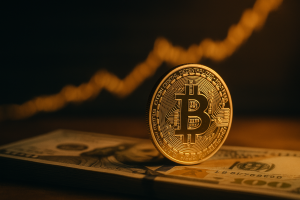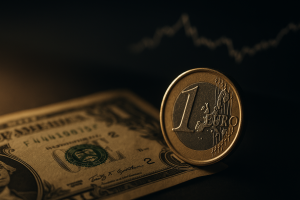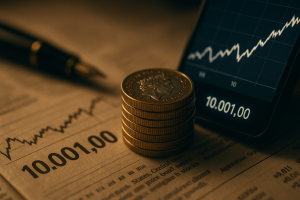En S&P 500 es uno de los índices bursátiles más seguidos del mundo. Sirve de barómetro de la economía estadounidense y de la confianza de los inversores. Pero lo que muchos operadores no saben es hasta qué punto el ponderaciones sectorialese incluso fuerzas macroeconómicas como la Índice del dólar estadounidense (DXY)...determinan su comportamiento.
Si es usted operador, inversor u observador macroeconómico, comprender lo que mueve el S&P 500 le proporciona una ventaja decisiva.
📊 ¿Qué es el S&P 500?
En S&P 500 (Standard & Poor's 500 Index) es un índice ponderado por la capitalización bursátil del Las 500 mayores empresas cotizadas en EE.UU. Representa aproximadamente 80% del valor total del mercado de renta variable estadounidenselo que lo convierte en un potente indicador de las tendencias generales del mercado.
Incluye empresas de todos los grandes sectores, que se agrupan en 11 categorías oficiales según la Norma de Clasificación Industrial Global (GICS).
🏦 ¿Qué sectores dominan el S&P 500?
Aunque el S&P 500 abarca todos los sectores, su ponderación dista mucho de ser equitativa. Algunos sectores de peso dominan el índice por capitalización bursátil.
Aquí están los los cinco primeros sectores por ponderación a partir de mediados de 2025:
1. Tecnología de la información (~29%)
- Empresas clave: Apple, Microsoft, Nvidia, Broadcom
- Por qué es importante: El sector tecnológico ha sido el motor de crecimiento del S&P 500 durante más de una década. También es muy sensible a los tipos de interés y a las expectativas de inflación.
2. Sanidad (~13%)
- Empresas clave: UnitedHealth, Johnson & Johnson, Eli Lilly
- Sector defensivo que tiende a obtener buenos resultados durante las fases bajistas del mercado debido a la inelasticidad de la demanda.
3. Finanzas (~11%)
- Empresas clave: JPMorgan Chase, Bank of America, Goldman Sachs
- Muy influido por la política de la Reserva Federal y el rendimiento de los bonos. A menudo se correlaciona inversamente con la tecnología.
4. Consumo discrecional (~10%)
- Empresas clave: Amazon, Tesla, Home Depot
- Impulsado por la confianza de los consumidores y el gasto minorista, es un buen barómetro de la salud económica.
5. Servicios de comunicación (~9%)
- Empresas clave: Alphabet (Google), Meta (Facebook)
- Mezcla de tecnología y medios de comunicación, este sector se comporta a menudo como un proxy tecnológico.
En conjunto, estos cinco sectores representan más de 70% del peso total del S&P 500lo que significa que su rendimiento influye en gran medida en los movimientos del índice.
💵 ¿Cómo afecta la fortaleza del dólar al S&P 500?
En Índice del dólar estadounidense (DXY) mide el valor del dólar en relación con una cesta de monedas extranjeras. Sus movimientos suelen estar correlacionados, o entrar en conflicto, con el rendimiento de la renta variable estadounidense.
He aquí cómo:
🔻 Un dólar fuerte puede perjudicar al S&P 500:
- Los exportadores sufren: Las empresas estadounidenses que dependen de las ventas internacionales (especialmente en los sectores tecnológico e industrial) pierden competitividad a medida que sus productos se encarecen en el extranjero.
- Presión sobre los beneficios: Un dólar fuerte reduce el valor de los ingresos extranjeros cuando se convierten a dólares.
🔺 Un dólar débil a menudo eleva el S&P 500:
- Aumento de los beneficios de las multinacionales: Las empresas con operaciones globales se benefician cuando los beneficios del extranjero se traducen en más dólares.
- Impulso de los precios de las materias primas: Sectores como la energía y los materiales suelen beneficiarse cuando un dólar más débil hace subir los precios de las materias primas.
Sensibilidad sectorial al dólar:
- Tecnología, industria y consumo básico son especialmente vulnerables a la fortaleza del dólar debido a su gran exposición al extranjero.
- Finanzas y servicios se centran más en el mercado nacional y se ven menos afectados por las fluctuaciones monetarias.
🔄 Por qué debería importar a los operadores e inversores
Cuando entiendas composición del sector y dinámica del dólarAsí, puede empezar a anticipar cómo podría comportarse el S&P 500 en diferentes condiciones macroeconómicas:
- ¿Subida del dólar + subida de tipos? Esté atento a la debilidad de las tecnológicas y a la fortaleza de los nombres defensivos.
- ¿Caída del dólar + mejora de las perspectivas mundiales? Es de esperar que los sectores en crecimiento, como el tecnológico y el de consumo discrecional, se sitúen a la cabeza.
Este tipo de conocimiento de los macro-sentimientos es lo que separa a los inversores medios de los grandes.
¿Quieres operar con el S&P 500 con precisión?
En Parqué EPIQAyudamos a los operadores a anticiparse a los cambios macroeconómicos con análisis en tiempo real, mapas de calor sectoriales y perspectivas de negociación que no encontrará en ningún otro sitio.
🧠 Aprende a operar:
- Índices de mercado como SPY y QQQ
- ETF sectoriales como XLK, XLF, XLE
- E incluso microfuturos como MES y MNQ para un control preciso
🎓 Además, accede a nuestro Academia de ComercioAdemás, le ofrecemos una amplia gama de herramientas de gestión, cuadros de mando macro en tiempo real y llamadas semanales en directo, todo ello diseñado para mantenerle centrado y rentable.
👉 Comience su prueba gratuita de 3 días ahora y lleve sus operaciones al siguiente nivel.
⚠️ Descargo de responsabilidad
Esta entrada de blog tiene únicamente fines educativos y no constituye asesoramiento financiero. Realice siempre su propia investigación y hable con un profesional cualificado antes de tomar decisiones de inversión.










Respuestas